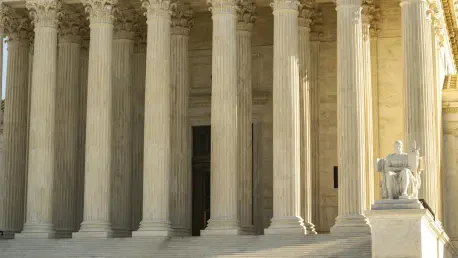In a landmark decision that could reshape the digital landscape, the Supreme Court upheld a Texas law mandating online age verification for adult entertainment websites, sparking a nationwide debate over free speech and privacy. The decision, reached with a 6-3 majority, marks a significant evolution in the ongoing battle between state-level legislative efforts to protect minors and the constitutional rights of adults to access information unrestricted. The ruling underscores a critical inflection point in the discourse surrounding digital content regulation, privacy concerns, and technological capabilities in effectively implementing age verification systems. The intricacies inherent in the ruling reveal the complex nature of balancing protective regulations with constitutional liberties, setting a precedent that could influence similar future laws across various states.
This decision comes in the wake of heightened national efforts to restrict minors’ access to explicit online content, with Texas pushing to lead the charge by reinforcing age verification protocols. The context traces back to a legislative initiative by Texas in 2023, where Governor Greg Abbott signed the bill to address concerns about children’s unfettered exposure to online pornography. This legislative move mirrored an earlier effort by Louisiana, which was the pioneer among U.S. states in implementing such age-restrictive measures. Consequently, the Age Verification Providers Association reported that 24 states have since adopted similar laws, indicating a growing trend toward regulatory vigilance concerning online content perceived as harmful to minors. The ruling has sparked conversations not only about legal parameters but also about the broader implications this decision holds for future legislative actions and technological initiatives designed to protect children online.
Navigating the Complex Web of Protection and Rights
The central themes driving this legislative and judicial development revolve around safeguarding minors, defending First Amendment rights, and tackling technological hurdles in age verification implementation. The law primarily aims to provide a protective shield for minors against premature exposure to content deemed inappropriate. Proponents of the law highlight the unique risks digital platforms pose, given their pervasive reach and ease of access by minors who often find themselves navigating these platforms unsupervised. The protection of minors remains a primary societal imperative, with stakeholders largely agreeing on the necessity of mitigating the potential harms of early exposure to adult content.
On the other side of the debate is the robust defense of First Amendment rights, which critics argue are jeopardized by laws that mandate such stringent regulations. Opponents insist that age verification could result in undue censorship and extend beyond its intended purpose, applying restrictive measures to speech that should otherwise remain free and unfettered. They argue that the absence of careful parsing of the implications on free speech might lead to an environment where lawful adult content is unnecessarily censored, effectively stifling the rights guaranteed by the First Amendment.
Beyond the legal and ethical arguments lies the practical question of implementing adequate age verification technologies. The challenge involves finding technological means that ensure accurate age verification without infringing on user privacy or causing prohibitive economic burdens to website operators. Concerns revolve around how these systems can verify age without resorting to invasive data collection methods, which could risk breaches of privacy or lead users to disengage from platforms entirely. The financial and logistical implications for website operators are significant, as they must invest in secure and feasible verification systems that comply with the law without detrimentally impacting their service delivery or user experience.
Supreme Court’s Rationale: Balancing Law and Liberty
In delivering the majority opinion, Justice Clarence Thomas articulated a vision that emphasizes the limited burden the law places on speech while reinforcing state powers to protect minors. The decision asserts that age verification presents only an incidental burden on adult speech, which does not merit the high bar of strict scrutiny. This interpretation aligns with the position that states possess traditional authority to regulate material deemed obscene or harmful to children, a point bolstered by precedent applications of intermediate scrutiny to similar cases where the challenged law serves significant state interests.
Justice Thomas reinforced that the state’s duties in providing a protective framework for children justify the necessity of such legislation, arguing that the law both addresses legitimate goals and avoids excessive encroachment on speech rights. The majority’s adoption of intermediate scrutiny reflects a willingness to accommodate state interests while preserving core constitutional protections, fostering a legal environment where the interests of children and adults coexist under a nuanced regulatory umbrella.
This decision is emblematic of how courts are navigating the complex interplay between free speech principles and the societal need to regulate unfettered access to adult content on digital platforms. Intermediate scrutiny, as a standard, provides a potentially more flexible legal framework that may allow room for states to tailor their regulatory approaches without automatically dismantling adult free speech rights. This aspect may influence other states in pursuing similar laws while encouraging further legal consideration of the balance between state authority and individual liberties in digital governance.
Differing Perspectives: The Dissent and Its Implications
The dissenting opinion offered by Justice Elena Kagan articulates a strong critique of the law’s potential overreach and its implications for free speech. Justice Kagan’s contention is that the ruling risks establishing a precedent for heightened governmental restrictions under the pretense of protecting minors, threatening to expand the scope of such laws beyond their intended boundaries. She underscored the necessity for clear evidence demonstrating that less restrictive measures cannot effectively achieve the protective aims lawmakers intend—an argument advocating for the preservation of the delicate balance between restriction and liberty.
Dissenters further argue that imposing cumbersome verification processes presents tangible barriers to lawful adult speech, thus positioning the decision as a direct challenge to First Amendment protections. The fear is that these processes could deter engagement with protected content, inadvertently stifling free expression due to the complexities and inconveniences involved in age verification. Kagan’s dissent reflects a broader concern for potential governmental overreach into the digital space, suggesting that the ruling might invite more intrusive governmental interventions, complicating the governance of online content and the freedoms associated with it.
The precedent concerns expressed in the dissent extend to the enduring implications for free speech jurisprudence, particularly in the digital context where legal boundaries remain fluid and subject to evolving interpretations. While the majority’s opinion seeks to balance state interests with constitutional protections, the dissent raises crucial questions about the long-term implications for free expression, urging a robust discussion on the appropriateness and sufficiency of current regulatory mechanisms.
Nationwide Impact and the Future of Digital Governance
The Supreme Court’s ruling has catalyzed a spectrum of reactions, with broad implications for digital governance and societal values concerning content protection measures. Advocates for stricter content regulations have lauded the decision as a pivotal step in securing the digital environment for minors, emphasizing the manageable nature of age verification as a reasonable method to achieve such security. Proponents argue that the decision reasserts the fundamental responsibility of states to enact measures that shield children while allowing adults reasonable access to protected content.
Conversely, the ruling has provoked significant backlash among free speech advocates and digital rights organizations, who voice apprehensions about the implications for privacy and the chilling effects on adult access to permissible content. Critics argue that the decision undermines the subtleties and protections of digital rights, failing to sufficiently address the complexities of online content regulation in a rapidly evolving digital age. The tension inherent in the ruling reflects the broader societal discourse surrounding the intricate balance between security, privacy, and freedom—a dynamic characteristic of digital governance in contemporary times.
This ruling is poised to influence policy discussions and technological innovations, propelling lawmakers and tech companies to navigate the intersection of regulation, privacy, and technological feasibility. There is an anticipated trajectory toward refining age verification technologies to minimize privacy intrusions while complying with legislative mandates. Furthermore, the decision may invigorate state governments to pursue similar laws, leading to an increased likelihood of subsequent legal challenges that will further shape the regulatory framework governing online content in the United States.
Navigating the Balance Between Expression and Regulation
The Supreme Court’s pivotal ruling to uphold a Texas law enforcing online age verification for adult websites is stirring a national debate on free speech and privacy. Decided by a 6-3 majority, the decision marks a major shift in the clash between state measures to protect minors and adults’ First Amendment rights. This decision highlights a key moment in the ongoing discussion about regulating digital content, safeguarding privacy, and the technological ability to enforce age verification effectively. The ruling’s nuances illustrate the challenge of balancing protective laws with constitutional freedoms, possibly shaping similar future laws across the United States.
This verdict follows increased efforts to limit minors’ exposure to explicit online material. Texas has spearheaded this movement by strengthening age verification requirements. This initiative traces back to 2023, when Governor Greg Abbott enacted the law to confront the issue of children’s unregulated access to online pornography. Texas followed in Louisiana’s footsteps, which initially introduced such legislation. Since then, the Age Verification Providers Association notes that 24 states have adopted similar regulations, highlighting a trend toward heightened regulatory scrutiny of online content considered harmful to minors. This decision not only fuels discussions about legal boundaries but also raises questions about its potential impact on future laws and tech-driven efforts to safeguard children online.









